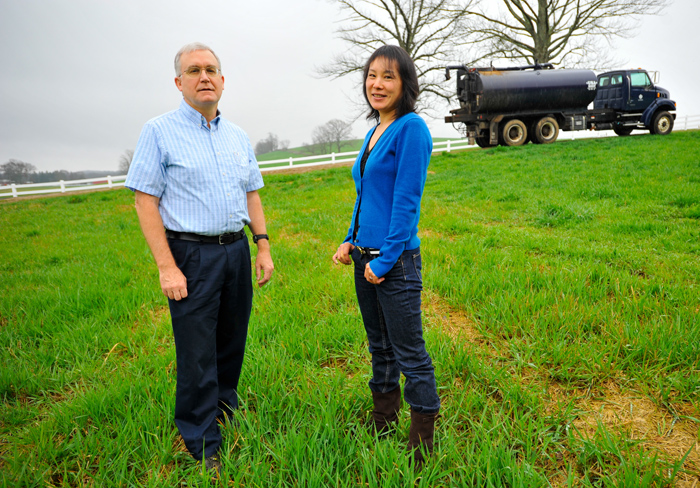
An average Connecticut dairy farm houses about 100 cows and can produce more than 275,000 gallons of milk per year. But these numbers fall far shy of another major farm product that doesn’t have quite the market value of milk.
“A large Connecticut dairy farm can produce up to 2 million gallons of manure in one year,” says Haiying Tao, a postdoctoral researcher in UConn’s Department of Plant Science and Landscape Agriculture. “These farms are confined, concentrated, and have many animals, and they have a lot of trouble converting their manure efficiently to fertilizer.”
When manure is correctly applied to these farmers’ croplands, it adds nutrients, promoting crop growth. But when it’s disposed of improperly, nutrients can leach out of the manure and into waterways, which can harm aquatic life.
In a new study, Tao and her postdoctoral adviser, plant science professor Thomas Morris, along with Boris Bravo-Ureta of the Department of Agricultural and Resource Economics and Richard Meinert of the Department of Extension, examined the effects of a federal program that gives incentives to farmers to reduce nutrient runoff. Under this plan, the researchers estimate that three out of four dairy farms could not only reduce their environmental impact, but could also turn a profit.
A Question of Distribution
Typically, farmers remove manure from their animal areas by piling it into trucks – sometimes repurposed tanker trucks that can hold four to six thousand gallons of manure each – and applying it to the farm’s croplands, which are mainly used to grow food for the animals.
But according to Morris, environmental problems usually arise not from the manure itself, but from its rate of application. Manure is costly to transport and distribute, and since milk is often sold at a rate lower than the cost to produce it, dairy farmers need to save money wherever possible. As a result, they typically apply large amounts of manure to a small number of fields in close proximity to their animal facilities, and this overloads the soil.
“It’s the phosphorus from the manure that creates the biggest problem,” Morris says. “We’ve been filling the soil with phosphorus for years, and now we need to stop.”
Although a portion of the nutrients do enrich the soil, the excess gets carried away in rainwater to the nearest body of water. Here, nutrients such as phosphorus can trigger harmful algal blooms, which can deplete the water’s oxygen supply and suffocate fish and other aquatic life.
One solution to these problems is for farmers to spread their manure more widely on more of their fields – the dairy farms in this study, representing medium and large dairy farms in Connecticut, have 60 to 250 fields each. This greater area of soil would be better able to absorb most of the nutrients. But, says Tao, farmers don’t regularly do this because it’s too costly.
“The major expenses to farmers are hauling and distributing the manure,” she says. “Training, labor, and record keeping are other minor expenses.”
Incentives, Costs, and Benefits
To encourage farmers to take on these added responsibilities, a program through the U.S. Department of Agriculture selects farms each year to receive incentives for implementing nutrient management plans. The farms receive advising services and $10,000 per year for the first three years; in exchange, they must test their fields’ soil nutrient content regularly and apply manure only to fields below a critical phosphorus level. The plan aims to reduce the risk of pollution of watersheds through land application of manure.
Over the span of six years, Morris and Tao measured the costs of manure handling and bookkeeping, the expected benefits of manure as fertilizer when spread more widely, and the resulting changes in net revenues associated with nutrient management plans implemented on two large and two medium-sized Connecticut dairy farms. Their estimates show that three of the four farms realized a net profit from implementing the plans, with one large farm reaping an estimated $17,600 yearly. The medium-sized farms incurred profits of $200 and $1,400, whereas the other large farm lost $2,900 per year.
Morris sees these results as an indication that the incentive plan should continue, and perhaps even become mandatory for large farms at some point in the future. But many farmers are skeptical that manure can fertilize their fields as well as commercial fertilizers. Morris admits there’s no foolproof way to accurately measure the fertilizer benefits to the land from manure applications, due to variations in the environment, such as temperature, rainfall, and other climatic factors. And this uncertainty makes farmers hesitant to go to the trouble of transporting the manure long distances.
“The farmers view the whole process as an extra cost, but many are willing to put in the effort because it’s good for the environment,” he says. “Most farmers view themselves as stewards of the land. It’s consumers’ demand for cheap food that makes it difficult for farmers to be the best stewards.”
The next steps, he argues, are to practice adaptive management techniques, in which farmers implement recommended land management practices, test them to see if they work, then adjust them, based on guidelines developed by a range of stakeholders, including farmers, scientists, agricultural service providers, environmentalists, and government regulators.
The guidelines should give farmers more confidence that they will see benefits from adopting nutrient management plans, Morris says. Overall, he thinks that costs associated with protecting the environment need to be included in the price of food.
“Concentrated livestock is a worldwide problem,” he says. “We’ve concentrated livestock for efficiency, but the external costs of doing so – the costs to the environment – are not included in our economic calculations.”


